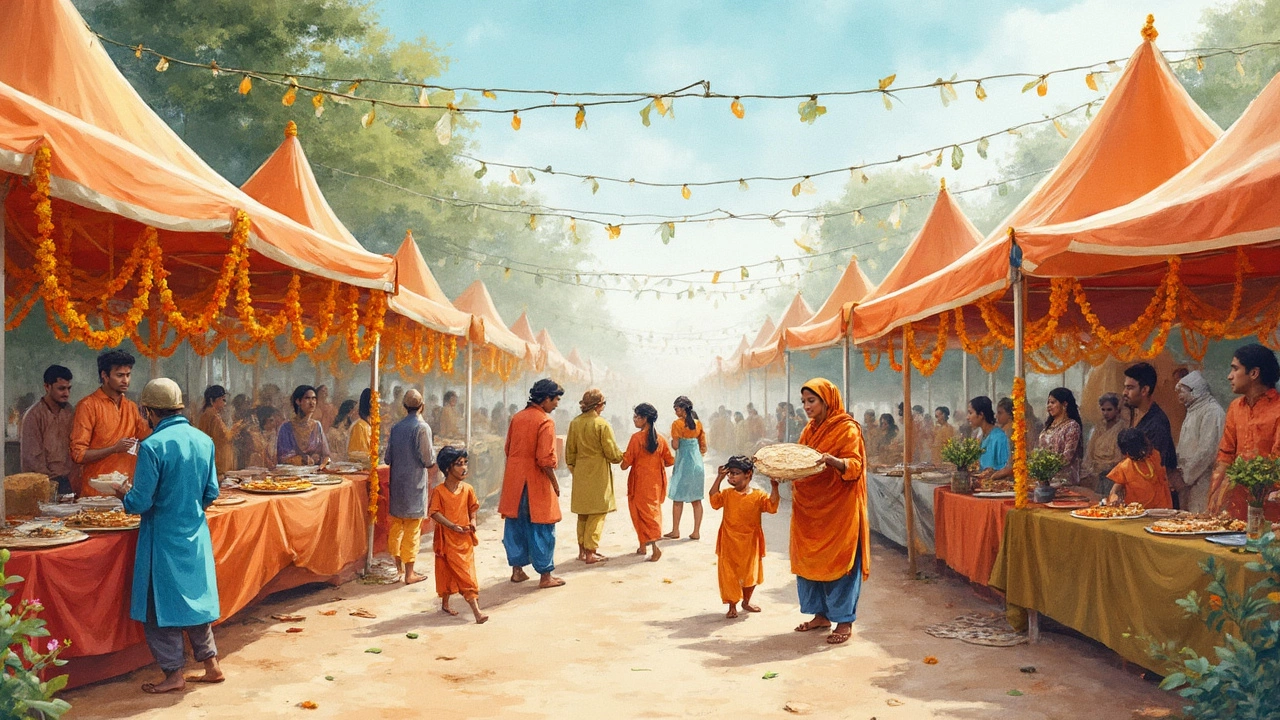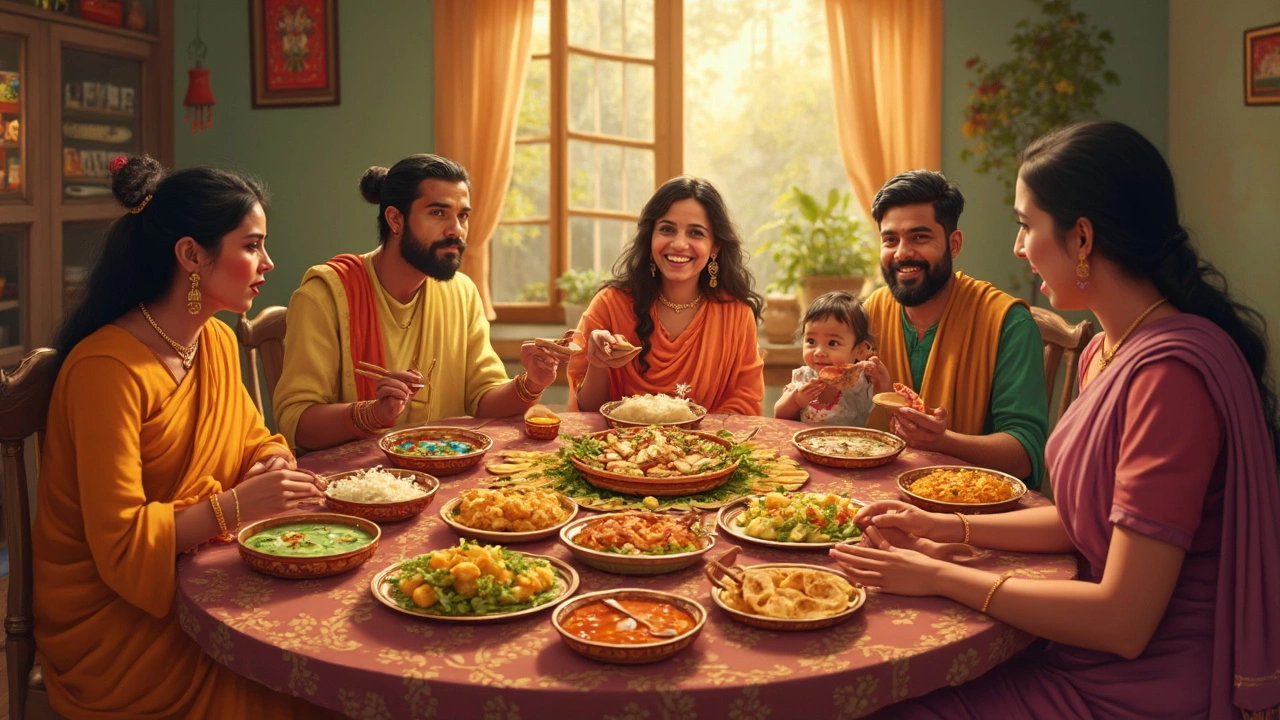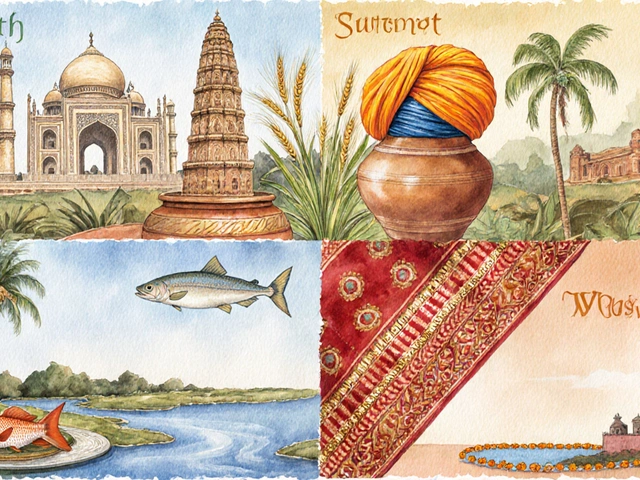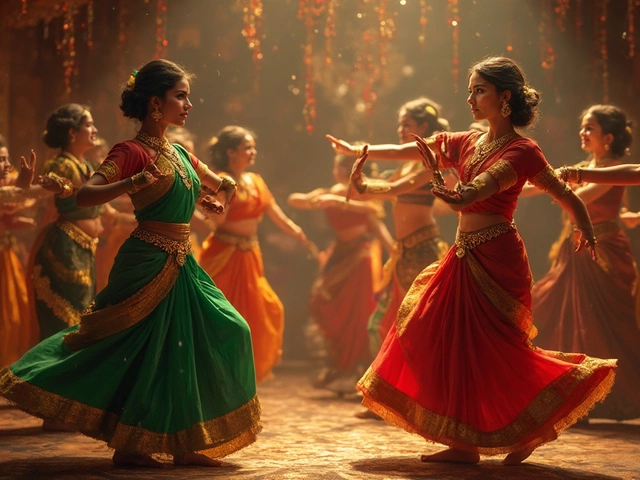Forget what you see in fancy restaurants—most Gujarati meals aren't over-the-top or dripping in oil. They're built for everyday life: balanced, light, and packed with flavor. At the core, it's not just about what’s on your plate, but how everything comes together—think big, round steel plates called thalis loaded up with tiny bowls, each holding something different.
What’s wild is how Gujarat landed this sweet twist in its food; even regular lentils and veggies come with a hint of jaggery or sugar. Locals claim it’s because the heat makes you sweat more—so you lose salt and sugar fast. Makes sense, right? So, don’t be shocked if your stewed daal tastes just a bit like dessert.
If you want to experience Gujarati food at its realest, skip the street snacks for a day and hit up a home or a traditional canteen at lunch. You’ll find steamed rice, soft rotli (wheat flatbreads), a seasonal veggie or two, and maybe a bowl of kadhi—a yogurt sauce that’s tangy and oddly soothing. There’s no fiery spice race here. It’s all about soft heat and bright flavors that make you want seconds.
- The Heart of a Gujarati Meal
- Thali: More Than Just a Plate
- Flavors and Staples You’ll Find
- Rituals and Mealtime Customs
- Tips to Recreate a Gujarati Meal at Home
The Heart of a Gujarati Meal
Ask anyone in Gujarat what home food means, and you’ll hear one word a lot: balance. A Gujarati meal is all about mixing savory, sweet, salty, and even a bit of sour in every bite. The goal is variety, not just in taste, but in texture. There’s always something soft (like rice or dal), something crisp (like papad), and something fresh (think salad or raw onions) on the table.
Most meals stick to seasonal, local veggies. Things like bottle gourd, potatoes, cucumbers, fenugreek leaves, and okra are popular choices—not because they’re fancy, but because they’re affordable and widely grown. Dairy sneaks into almost every dish, whether it's a spoonful of homemade yogurt or a drizzle of ghee. Even people who aren’t big milk drinkers end up taking a little, since it’s believed to cool the body—especially in Gujarat's steamy summer months.
Typical family lunches or dinners are centered on a few basics:
- Steamed rice (called bhaat)
- Chapati or rotli (flat wheat breads, usually fresh off the pan)
- A lentil-based curry like dal or sprouted moong
- One or two sabzis (vegetable dishes), often cooked with just a pinch of sugar
- Chaas (a salty yogurt drink), which helps beat the heat
- Pickles and papad for crunch and zing
Here’s something cool: according to a National Family Health Survey from 2021, almost 80% of Gujarati households cook vegetarian meals every day. That’s not about religion alone, but also price and climate—it’s just easier to get fresh veggies year-round in Gujarat than to buy meat or fish.
| Item | How Often Served |
|---|---|
| Rice | Daily |
| Rotli | Daily |
| Dal | Almost Daily |
| Savory Veggies | Daily |
| Sweets (like shrikhand, mohanthal) | Mostly on weekends or festivals |
Don’t be surprised if dessert lands in the middle of your meal—not at the end. Sweets like shrikhand or aamras get scooped up with bread, mixing straight in with the rest. It might seem weird if you’re used to Western routines, but for Gujaratis, it’s just how things go. And if you ever find yourself at a local dinner, eat with your hands! It’s how you mix the flavors right at the table, and it’s half the fun.
Thali: More Than Just a Plate
If you ask anyone in Gujarat, the thali isn’t just a plate—it’s a full-on experience. Picture a big steel platter with a circle of little bowls, all filled with different dishes, and you’ve got a real Gujarati thali. It’s not random; there’s a rhythm to where each item sits and what goes together. This isn’t just about variety. It’s about balance: sweet, salty, spicy, and sour, all on one plate.
Back in the 1950s, proper restaurants started serving thalis to save the hassle of ordering each dish. In busy cities like Ahmedabad, huge canteens serve thousands of thalis during lunch rush. The Gujarati meal thali has secured national fame for good reason—no two thalis are exactly the same, but some items are must-haves:
- Roti or Rotli: Soft wheat flatbreads, perfect for scooping up curry
- Rice: Usually plain or sometimes flavoured with cumin (jeera)
- Dal or Kadhi: Yellow split lentils or a yogurt-based, slightly sweet curry
- Shaak (Vegetable Curries): Could be anything seasonal, from potatoes and peas to okra
- Farsan: Savoury snacks like dhokla or khandvi
- Papad: Crunchy lentil crackers
- Pickle & Chutney: For a sour or spicy kick
- Sweets: Maybe mohanthal, shrikhand, or fresh fruit depending on the day
What most people don’t notice is the subtle etiquette. You always start with dry snacks and finish with something sweet. Friends joke that if you leave a bowl unfinished, the servers will actually sneak another helping onto your plate. It’s endless refills until you tap out or cover your plate with your hand.
Here’s a breakdown of the basic thali line-up you’d spot in a classic Gujarati-run canteen:
| Component | Purpose | Typical Example |
|---|---|---|
| Grain | Starch/Base | Rotli, Rice |
| Legumes | Protein/Comfort | Dal, Kadhi |
| Vegetable dishes | Nutrition/Variety | Aloo Matar, Bhindi Shaak |
| Farsan | Snack/Texture | Dhokla, Patra |
| Sweets | Finish/Tradition | Shrikhand, Mohanthal |
| Accompaniments | Flavor Boost | Pickle, Chutney, Papad |
If you ever snag a seat at a busy thali joint, here’s a tip: pace yourself. Refills keep coming until you signal stop, so don’t let the unlimited rice fool you into missing out on the sweets at the finish line.

Flavors and Staples You’ll Find
Ask anyone about a typical Gujarati meal and you’ll hear about that sweet-salty combo straight away. What throws some people is how sugar or jaggery slips into almost every dish. Why? It’s not just for taste. Sugar helps balance the natural bitterness in certain veggies and keeps you going in Gujarat’s dry, hot climate.
Let’s talk about the real basics—the meal always centers around a grain. Most days, that’s either rice or soft, thin rotli (wheat flatbreads). Rotli is extra special here: it’s rolled out paper-thin and cooked just right, kind of like a gentle cousin to a tortilla. On the side, you’ll get a dal—yellow lentils cooked up with cumin, turmeric, and yeah, a little sweetness. Then there’s shaak, which just means veggie curry. Whatever’s in season shows up, like potatoes with fenugreek (methi bateta), or cauliflower tossed with peas.
Another big player is Gujarati meal kadhi, a yogurt-based sauce that’s sweet, tangy, and sometimes even a little spicy. It usually goes over rice and cools you right off. Don’t miss snacks like dhokla (steamed chickpea cakes) or khandvi (rolled-up spicy besan sheets), which might show up during festival times or if you’re at someone’s place for a feast.
Let’s not forget farsan—savory snacks served to start the meal or as sides. People love things like crispy gathiya or patra (spiced colocasia leaves), and these aren’t just party food. In a big family meal, a little mound of farsan makes it all feel more festive.
Honestly, it’s impressive how much flavor they get out of simple cooking. Most dishes have cumin, coriander, mustard seeds, turmeric, sometimes asafoetida (called hing), and always a squeeze of lemon or raw mango for tang. If you’re a heat-seeker, though, Gujarati food isn’t out to kill you with chilis—it’s about balance, not burn.
Rituals and Mealtime Customs
Mealtime in a Gujarati home is about more than just filling your stomach. There are little steps and customs that make it feel like a family event, not just a meal. First off, most families eat together. It's common to sit down for lunch as a group, especially on weekends. You’ll see many folks wash their hands right before eating, which actually lines up with the old tradition of eating with your hands—and yes, people still do it for home-cooked meals.
Food is always served fresh, and usually in small portions. Refills? Absolutely. In fact, it’s pretty much expected that you’ll be offered another serving as soon as your bowl is empty. Refusing food can feel awkward, but it’s not rude to just say “I’m full”—everyone understands, especially after the third round.
Here’s a cool thing: serving order matters. The eldest (or a guest) gets served first, showing respect. The thali itself has a set layout—sweet, savory, breads, rice, and yogurt have their specific places. Water is poured last, right before you start, since it’s considered bad luck to keep an empty glass on the table.
- Hand-washing before meals is an absolute must.
- Meals kick off with a bit of prayer or thanks, especially during festivals.
- Most folks sit cross-legged on the floor for traditional meals (called a 'pangat'), though many families now use dining tables.
- Food is shared, and the host will keep refilling your plate—take it as a sign of good hospitality, not force.
Curious how all this lines up in daily life? Here’s a table with some quick data on typical habits from a 2023 survey on Gujarati eating customs. The numbers show just how much these rituals stick, especially at family get-togethers.
| Custom | Percentage of Families Following |
|---|---|
| Family eats together for main meal | 79% |
| Host serves guest’s plate first | 85% |
| Use of handwashing before meals | 91% |
| Serving food in thali style for lunch | 68% |
| Prayer before starting meal | 62% |
At the end of the day, a Gujarati meal is as much about the people and the rituals as the food itself. Joining a meal in a local home is like getting a backstage pass to what makes Gujarati culture tick.

Tips to Recreate a Gujarati Meal at Home
Getting that proper Gujarati vibe in your own kitchen isn’t about tracking down rare ingredients or mastering restaurant tricks. It’s about nailing balance, pacing yourself, and knowing just a handful of little secrets.
If you’re new to this, start with the classic Gujarati meal thali. You want different tastes on your plate—sweet, salty, sour, and a gentle heat. Here’s how you can stack up the basics (and yes, there’s flexibility):
- Rotli (flatbread): Wheat flour, soft and thin. Puff these on a dry pan and keep them wrapped in a towel so they stay soft.
- Rice: Steamed plain rice works. Don’t overcook it—separate, fluffy grains are the goal.
- Daal: Yellow moong or toor dal, cooked soft and with a touch of sugar, turmeric, and green chili. You want it soupy, not thick.
- Shaak (vegetable curry): Seasonal veggies are key. Potatoes, bottle gourd (dudhi), or peas with basic tadka (spices fried in oil). One sweetish and one savory is common.
- Kadhi: Yogurt and besan (chickpea flour) whisked and boiled with ginger, green chili, and sugar.
- Accompaniments: Chutney, kachumber salad, papad, and a small piece of jaggery for that sweet finish.
As chef Tarla Dalal once said,
"Gujarati food is all about playing with flavors. Even simple home food feels festive with just a little planning."
There’s no strict rulebook, but these quick tips help you get it right:
- Don’t skip the sweet element in the daal or shaak. It’s the signature move.
- Tempering (tadka) is not optional—oil, mustard seeds, cumin, dried chili, and curry leaves boost everything.
- Kadhi is supposed to be thin and runny, not thick like Punjabi kadhi.
- Use a pressure cooker for daal to get the perfect mushy texture quick.
- Work on portion sizes—Gujarati meals look big because they are served in small bowls arranged in a thali.
| Ingredient | Approx. Quantity (for 4) |
|---|---|
| Wheat flour | 3 cups |
| Rice | 2 cups |
| Moong or Toor dal | 1 cup |
| Yogurt | 2 cups |
| Mixed seasonal vegetables | 3 cups (chopped) |
| Jaggery or sugar | 2 tbsp |
| Spices & condiments | Common Indian spices + curry leaves |
If you want to feel a proper Gujarati meal at home, don’t stress about perfection. Go for balance, toss a bit of sweetness in, and try serving your meal family style. The best stories get told over thali, anyway.





